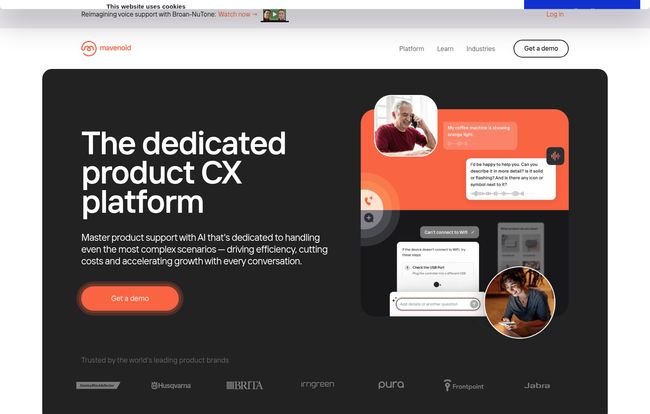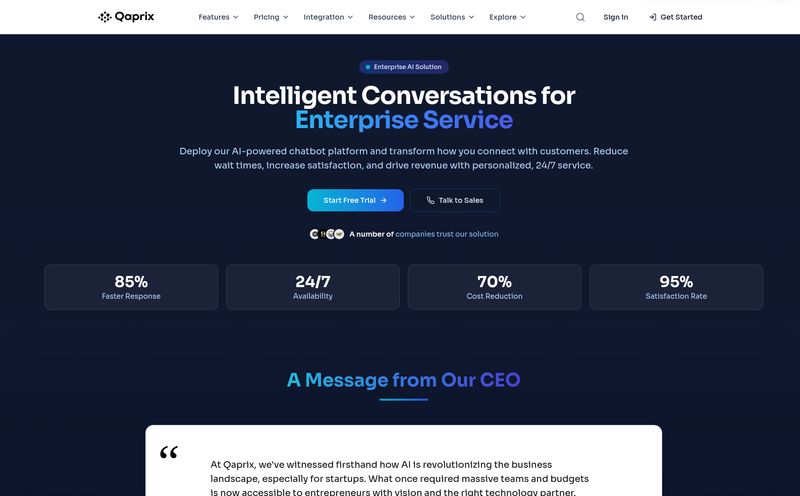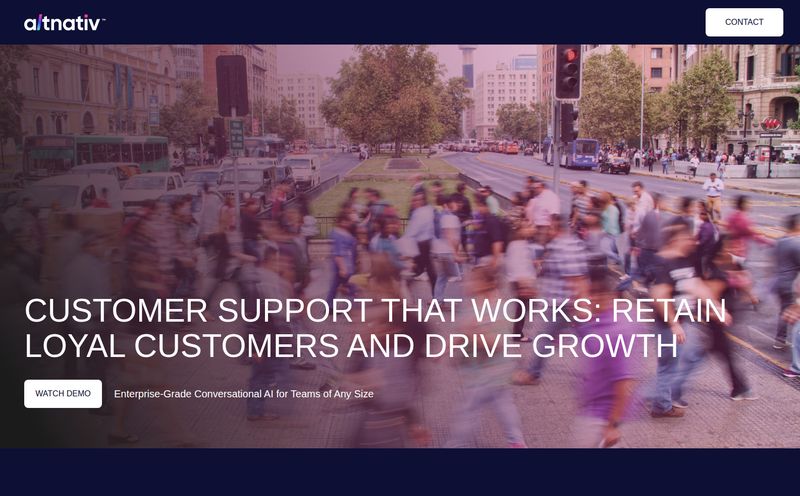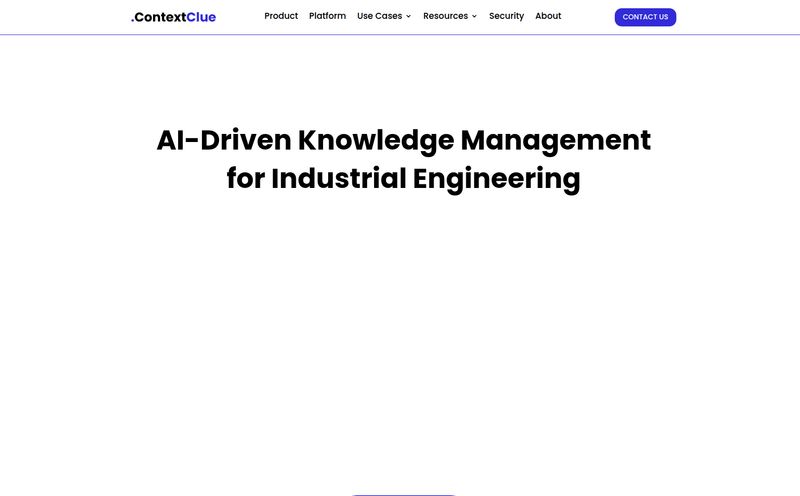When you hear “AI-powered customer support,” you probably get a cold shiver down your spine. I know I do. We’ve all been trapped in chatbot hell, screaming “HUMAN AGENT” at our phones while a bot cheerfully offers us irrelevant FAQ articles. It’s a modern-day form of torture.
So, when I first came across Mavenoid, I was skeptical. Another AI platform promising to revolutionize support? Sure. But the more I looked, the more I realized... this is different. It’s not trying to be a generic, catch-all customer service bot. It’s a dedicated Product CX Platform. And that small distinction changes everything.
It's designed specifically for the messy, complicated, pull-your-hair-out world of product support. Think less “Where is my order?” and more “Why is my smart fridge making a weird humming noise and only dispensing crushed ice?”
So, What Exactly Is Mavenoid, Anyway?
Forget the generic chatbot for a second. Think of Mavenoid as a product savant you’ve hired. A digital brain that has obsessively studied every single screw, wire, and software quirk of what you sell. Its whole purpose is to guide your customers through complex troubleshooting, step-by-step, without needing a human to intervene. It’s built to handle the nitty-gritty.
The platform claims it can drive efficiency, slash support costs, and help you grow with every conversation. Big claims, I know. But they’re backing it up with a suite of tools designed to create a self-service ecosystem that actually works. We’re talking about a system that boasts a 58% self-service resolution rate. That number alone made me sit up and pay attention.
The Core Features That Make It Tick
Mavenoid isn’t just one thing; it's a combination of tools working together. It’s like the Avengers of product support, but with fewer capes and more algorithms.

Visit Mavenoid
The Virtual Assistant and Voice Assist
This is the customer-facing part of the operation. It’s the AI your customer interacts with via chat on your website or even over the phone with Voice Assist. But unlike the bots we all love to hate, this one is hyper-focused. It uses what Mavenoid calls “context-aware self-service.” It asks diagnostic questions, analyzes the answers, and provides a tailored troubleshooting flow. It's like having an engineer on call, 24/7.
The Dynamic Help Center
This isn't your grandpa's static FAQ page. A traditional help center is a library; you have to know what book you're looking for. Mavenoid’s Dynamic Help Center is more like a librarian who walks you right to the specific paragraph you need. It adapts and presents information based on the user's problem, guiding them instead of just giving them a wall of text. A small change in approach, but a massive change in user experience.
A No-Code Platform for Us Mortals
Here’s the part that really gets me excited. It’s a no-code platform. I’ve spent more late nights than I care to admit trying to wrestle with custom-coded support solutions that a developer built three years ago and then promptly left the company. The ability for a non-technical product manager or support lead to build, tweak, and manage complex troubleshooting flows without writing a single line of code? That's not just a feature, thats a gift.
Insights That Matter
Great support isn’t just reactive; its proactive. The Insights feature gathers data on every interaction. It shows you where customers are getting stuck, what parts of your product are causing the most issues, and how your support flows are performing. This is the goldmine. You can use this data to improve your products, update your documentation, and stop problems before they even start. It turns your support center from a cost center into a valuable R&D resource.
The Good, The Bad, and The AI
No tool is perfect, right? Even one as slick as Mavenoid. It's important to go in with your eyes open. Based on my analysis and industry experience, here’s my honest take.
Why You Might Actually Love It (The Pros)
First off, the cost reduction is real. If you can automate the resolution of even 30-40% of your complex support queries (and they claim 58%!), the savings on agent time are immense. This also frees up your expert human agents to handle the really unique, high-stakes problems. The result is better, faster support for everyone. The consistency is another huge win. The AI gives the same, perfect, on-brand answer every single time, across every touchpoint. No more depending on whether the agent had their morning coffee or not. Plus, because it's built to integrate with heavy-hitters like Salesforce and Zendesk, it can slide right into your existing workflow. For global brands, the scalability across languages is a massive bonus.
Some Things to Keep in Mind (The Cons)
Okay, lets get real. AI isn't magic. The biggest hurdle is the initial setup. You have to feed the machine. Mavenoid needs your product documentation, troubleshooting guides, and historical support data to become that product savant. Garbage in, garbage out. The quality of your AI support will directly reflect the quality of the information you provide it. There's also a reliance on AI accuracy. While it’s designed for complexity, there will always be edge cases or novel problems it hasn’t seen before. This leads to the most important point: you absolutely need a smooth, elegant process for handing a customer over to a human agent when the AI hits its limit. Dropping the ball here can ruin the entire experience.
Who Is This Really For?
After looking at their case studies with companies like Jabra and Frontpoint, it's clear who wins with Mavenoid. If you sell a physical or digital product that requires any kind of setup, troubleshooting, or technical understanding, you are the target audience. Think consumer electronics, smart home devices, industrial machinery, medical devices, even complex software.
If you're a simple ecommerce store selling t-shirts, this is probably overkill. But if your support team is constantly explaining how to pair a Bluetooth device, reset a sensor, or configure a software setting, then Mavenoid is speaking your language.
Let's Talk Money: Mavenoid Pricing
And now for the million-dollar question: what does it cost? Well, if you go looking for a pricing page on their site, you might hit a 404 page, as I did. Don't panic. This is actually pretty standard for high-end, enterprise-focused SaaS platforms.
"Pricing is almost never one-size-fits-all for specialized enterprise tools. The value and cost depend entirely on your scale and complexity."
The cost will likely depend on your support volume, the number of products you have, and the specific features you need. Your best bet is to use their "Get a demo" button. That’s the only way to get a real sense of the investment required for your specific situation.
My Final Verdict: Is Mavenoid Worth the Hype?
In a world of disappointing chatbots, Mavenoid feels like a breath of fresh air. It knows what it is and what it isn’t. It’s not a general-purpose AI; it’s a highly specialized tool for a very specific, and very painful, business problem: complex product support.
I think for the right company, this could be a game-changer. It’s a strategic investment in customer experience that promises to pay for itself through efficiency and data-driven product improvements. It's not a plug-and-play fix, it will require work to set up. But the alternative—endlessly scaling a human support team to handle repetitive-but-complex issues—is a path filled with high costs, burnout, and inconsistency. If that's the pain you're feeling today, then yes, I’d say Mavenoid is absolutely worth a serious look.
Frequently Asked Questions about Mavenoid
1. What kind of products is Mavenoid best for?
Mavenoid shines with products that have a level of technical complexity. This includes consumer electronics, home appliances, smart devices, industrial equipment, medical devices, and sophisticated software applications where users might need help with setup, troubleshooting, or usage.
2. Do I need a developer to set up and manage Mavenoid?
No, and that's one of its main selling points. Mavenoid is a no-code platform, meaning your product experts or support team leads can build and maintain the troubleshooting flows without needing to write any code.
3. How does Mavenoid integrate with tools like Zendesk or Salesforce?
Mavenoid is built to work with your existing support stack. It integrates with major CRMs and helpdesks to do things like create tickets, sync customer data, and facilitate a smooth handover from the AI to a human agent within the tool your team already uses.
4. Is Mavenoid secure for handling customer data?
Yes. Security seems to be a priority for them. The website lists several major compliance certifications, including SOC 2, ISO 27001, HIPAA, and GDPR, which are critical standards for handling customer and patient data securely.
5. Can Mavenoid support customers in different languages?
Absolutely. The platform is designed to be scalable across different languages and markets, making it a strong choice for global companies looking to provide consistent support experiences worldwide.
6. What happens if the AI can't solve a customer's problem?
This is a crucial part of the process. Mavenoid is designed for intelligent escalation. When the AI determines it can't solve the issue or if the customer requests it, it can seamlessly hand the conversation—along with all the diagnostic information it has already gathered—over to a live human agent.
The Future is Self-Service
The days of simply throwing more people at a support problem are numbered. The future belongs to smart, scalable systems that empower customers to solve their own problems. Tools like Mavenoid aren't just about cutting costs; they're about meeting modern customer expectations for immediate, accurate, and accessible support. It's a different way of thinking about the customer relationship, and frankly, it's about time.
Reference and Sources
- Mavenoid Official Website
- The Customer Service Revolution Is Self-Service - Forbes
- Zendesk Customer Experience Trends Report



